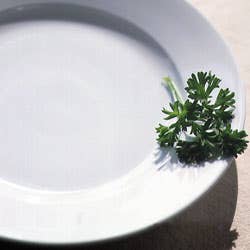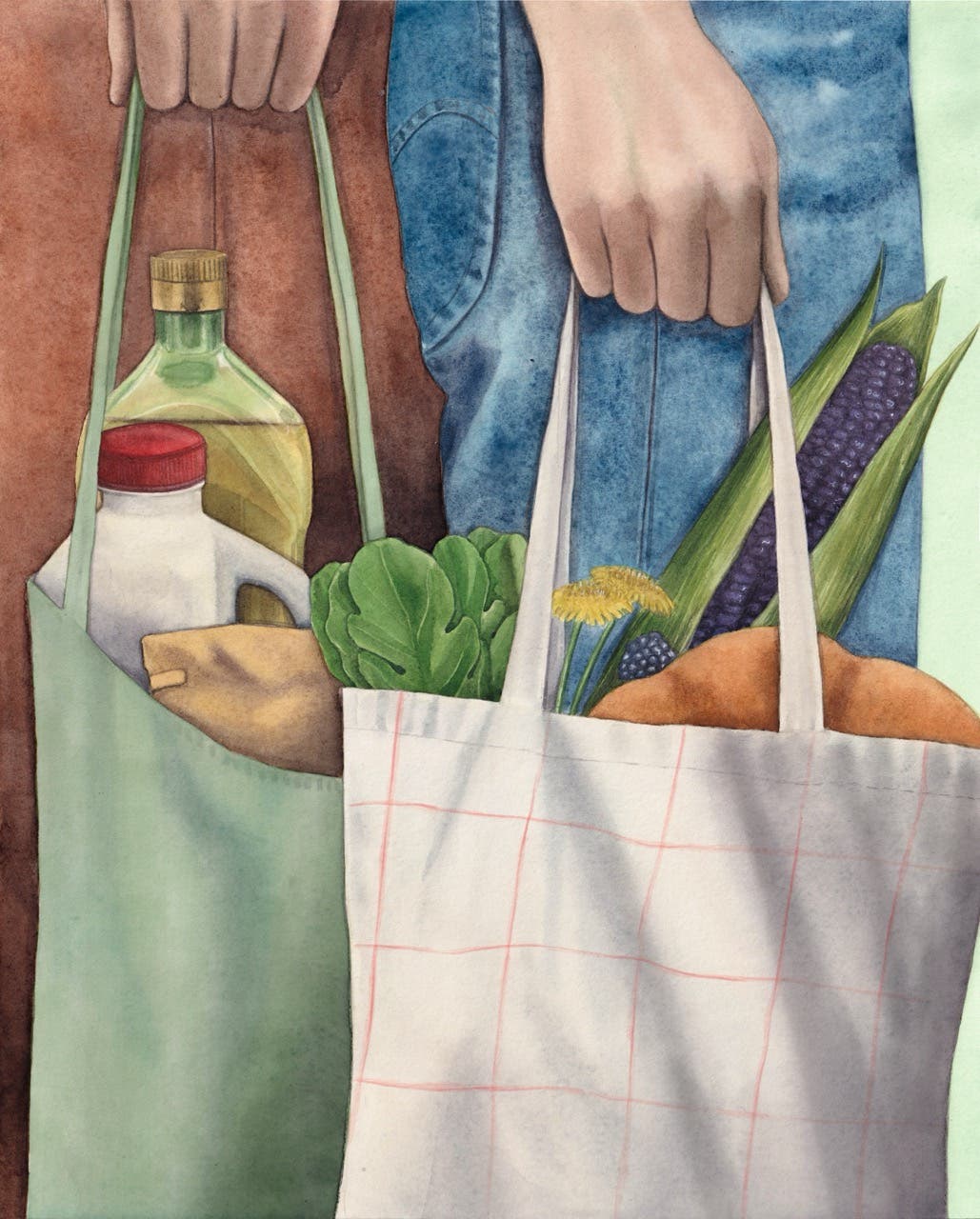
It’s Not Easy Being Green
Parsley gets taken for granted, dismissed as mere garnish, but it’s time this spirited herb gets the respect it deserves.
Parsley has always struck me as the culinary equivalent of air: It's everywhere, and thus easy to take for granted. Move parsley from the side of the plate to the center, however, and it will be noticed. Even appreciated.
To judge from most cookbooks, parsley's chief virtue—aside from a bright green color capable of perking up the brownest or grayest food—is that it never intrudes on a dish, let alone overwhelms it. But parsley is actually much more than a curly flash of green off to the side of a dinner plate or a scattering of tiny flakes in a salad or stew. Not only does at least one variety of it have a surprisingly vibrant flavor once you really stop to taste it, but, like most herbs, it has a rich, proud history—and not only as a comestible.
Americans have access to three forms of parsley—which is a member of the Umbelliferae family, and a close cousin of the carrot—but only two of these, curly parsley and the flat-leaf type, both cultivated varieties of Petroselinum crispum, are likely to be lying alongside the scallions at your local supermarket. The latter, often labeled Italian parsley, is by far the more pungent. The curly version is the garde-manger's best friend, more appealing to the eye than the palate.
The third kind of parsley, Petroselinum crispum var. tuberosum, also called Hamburg, rooted, or turnip-rooted parsley, is sold in the late fall and winter at farmers' markets and specialty food markets. It's a two-for-one investment, since both the lacy-looking leaves and the parsnip-like root can be eaten. Parsley root, similar to celeriac, is used extensively in soups and stews in Eastern Europe, but is also excellent pureed with cream and butter and seasoned with its own delicate leaves.
So-called Chinese parsley, incidentally, isn't parsley at all. It's cilantro, the leaves of the coriander plant. Though it may look a lot like flat-leaf parsley, it has a very different flavor and aroma, which people tend either to love or to hate.
Parsley's scientific name derives from the Greek petros, meaning rock (for the rocks among which the herb grew wild along the Mediterranean), and selinon, celery, whose leaves it resembles. The English name is a corruption of those words.
The Greeks may have named it, but they were not particularly taken with parsley as a food; they mostly fed it to their warriors' horses. Otherwise, they used the leaves for decoration, and wove it into the wreaths placed on the heads of winners of athletic games. The Greeks also scattered parsley over tombs as homage to Archemorus, the herald of death, and if someone was said to "need only parsley," that meant that he'd soon go off to that great herb garden in the sky. But parsley could symbolize beginnings as well as endings: The Greeks planted parsley along with rue to mark the borders of their vegetable plots. To be "at the parsley and the rue," then, signaled the beginning of a project.
Parsley was also used to ward off drunkenness: The Greeks and Romans both wore necklaces of the green leaves to combat what they supposed to be the effect of wine fumes. If nothing else, the high chlorophyll content of parsley had to make for fresher-smelling banquet halls. For somewhat the same reason, parsley is often prescribed as a breath-freshener, particularly after garlic is eaten, although no scientific studies have ever actually proved its effectiveness.
Over the millennia, parsley has also been touted as an antidote to ailments as disparate as kidney stones, rheumatism, and prostate trouble. As long ago as the second century A.D., the Roman physician Galen wrote that parsley was soothing to the stomach. And the 15th-century Italian writer Platina credited it with curing everything from dog and scorpion bites to menstrual cramps. Researchers today have decided that many of its merits lie in its high nutritional content; it is loaded not only with chlorophyll but vitamin C and especially vitamin A—of which it is the single richest plant source.
In medieval times, parsley, a slow-growing herb, became a powerful symbol for the superstitious because of a widespread belief that before its seed germinated, it made seven long voyages down to the devil's lair and back. One dark ritual called for dispatching an enemy by picking parsley while muttering the victim's name; he or she supposedly would expire within 48 hours. The French only abandoned their belief in such black magic in the ninth century, after Charlemagne ordered parsley planted in his gardens. In England, today, little children who ask where they came from are sometimes still told not that the stork brought them, but that they were dug up in a parsley patch.
Symbolic value aside, parsley has been a kitchen staple since Roman times. A salad recipe from 14th-century England combines parsley, sage, garlic, scallions, onions, leeks, borage, mint, fennel, watercress, rosemary, and purslane, with a dressing of oil, vinegar, and salt. In France, around the same period, Taillevent gave a recipe for verde sauce, made with parsley, ginger, vinegar, and soaked bread. In recent centuries, the French have put parsley to work in more lyrical combinations—with thyme and bay leaves in a bouquet garni to flavor stocks; with lemon juice in maitre d'hotel butter; with chives, chervil, and tarragon in fines herbes; and with chopped garlic in persillade, a pungent seasoning added to stews and other dishes at the end of cooking. Parsley is also a key component of classic tartar sauce, sauce ravigote, and of course the Burgundian specialty Jambon Persille, a kind of terrine in which a puree or mince of the vibrant leaves is suspended in gelee as a contrast to bits of rich, salty ham. French chefs also traditionally deep-fry parsley sprigs—an idea that passed briefly through trendy American kitchens years ago, and deserves to be revived.
Parsley has always figured heavily in Italian cooking, as well. As Anna del Conte notes in her Gastronomy of Italy, "Oil, garlic and parsley is one of the most perfect combinations of flavors." In Italy, the herb is usually cooked with other ingredients rather than just sprinkled onto things. In Catalonia, where parsley is known by the pretty name of julivert, it's almost inevitably used every time garlic is (which is a lot), both for flavor and because it's thought to make garlic more easily digestible. In the Middle East, the herb is eaten as a green, turning up in tabbouleh, a salad of bulgur wheat and tomatoes, or in other first-course salads, dressed with tahini or enriched with chunks of feta. Even far from the Mediterranean, in Russia and Scandinavia, parsley is widely used as both garnish and flavoring for smorgasbord sandwiches and salads.
Parsley was apparently introduced to North America by European settlers, although many early accounts refer to it as growing wild here. Waverley Root, who tracked the first appearance of the word in print in this country to 1806, says it's more likely that seeds were brought over by some of the earliest explorers or fishermen along the New England coast. Even after all these years, though, parsley isn't exactly an essential for any all-American dish. Cajun cooks, though, are particularly fond of it, using freshly chopped parsley, along with their holy trinity of peppers, celery, and onions, in gumbos, jambalayas, and etouffees. And the Shakers, renowned for their use of herbs, are also parsley partisans; one Shaker cookbook counts it among the "soup herbs" that "add depth to almost any dish."
Even though fresh parsley is almost always available in supermarkets, dried parsley, an inferior product, remains a staple there, sitting right alongside the dried oregano and the whole peppercorns in the spice department. Commercial parsley is a biennial grown as an annual: The first year it produces only leaves, but that's all harvesters need. Machines much like those used to reap soybeans or corn are also used in parsley fields, chopping off the tops of the plants; the same field can be cut up to five or six times in a year. Crops must be rotated after one year, though, or a fungus sets in. Once the leaves are trimmed and washed, they are sent on conveyor belts through mechanical dryers before packing.
Anyway, why buy the stuff? Fresh parsley is ubiquitous, and is easy to store and use. I always try to keep some of the flat-leaf variety in my refrigerator. A big bunch will last for weeks in a plastic bag, and I can chop it fast and add it to just about any dish for a vibrant flavor.
I never realized how important it was to me until recently, when I tried to make a pasta sauce out of pantry staples—and discovered that my parsley bag was empty. The sauce turned out fine, but it lacked, well, a certain something—something more than just a bit of color. That's another way parsley is like air: If you don't have it, you'll soon notice that it's missing.
Keep Reading
Continue to Next Story










